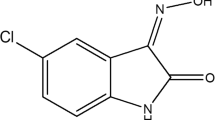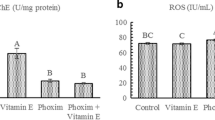Abstract.
Methidathion (MD) [O,O-dimethyl S-(2,3-dihydro-5-methoxy-2-oxo-1,3,4-thiadiazol-3-ylmethyl) phosphorodithioate] is one of the most widely used organophosphate insecticides (OPIs) in agriculture and public health programmes. We have, therefore, examined the in vivo and in vitro effects of MD on the serum activities of cholinesterase (ChE), enzymes concerning liver damage and lipid peroxidation (LPO; only in vivo), and have evaluated the ameliorating effects of a combination of vitamins E and C against MD toxicity. The in vivo experimental groups were: control group, MD-treated group (MD), and a group treated with MD plus vitamin E plus vitamin C (MD+Vit). The MD and MD+Vit groups were treated orally with a single dose of 8 mg MD/kg body weight at 0 h. Vitamin E and vitamin C were injected at doses of 150 mg/kg body weight i.m. and 200 mg/kg body weight i.p., respectively, 30 min after the treatment with MD in the MD+Vit group. Blood samples were taken 24 h after the MD administration. For in vitro study, venous blood samples were obtained from volunteers, and serum recovered. The activities of serum enzymes were determined in each sample and these served as 0 h values. Each sample was divided into four portions, each of which served as one of the experimental groups, as follows: control group, vitamin E plus vitamin C group (Vit), MD-treated group (MD) and MD plus vitamin E plus vitamin C group (MD+Vit). Vitamin E and vitamin C were added at doses of 7.5 and 10 µg/ml, respectively, into the Vit and MD+Vit groups. MD was added at doses of 0.4 mg/ml into the MD and MD+Vit groups. The activities of serum enzymes were determined in each sample at 24 h. The results of the in vivo experiment demonstrated that thiobarbituric acid reactive substances were increased in the MD group compared with the control group, and decreased in the MD+Vit group compared with MD group. ChE activity was decreased in both MD and MD+Vit groups compared with controls and increased in the MD+Vit group compared with the MD group. The activities of aspartate aminotransferase (AST), alkaline phosphatase (ALP), γ-glutamyltransferase (GGT) and lactate dehydrogenase (LDH) were increased in both the MD and MD+Vit groups compared with the control group. AST activity was decreased in MD+Vit group compared with the MD group. Alanine aminotransferase (ALT) activity was decreased in both the MD and MD+Vit groups compared with control group. The results of in vitro experiment showed that all enzyme activities remained unchanged in both the control and Vit groups compared with values at 0 h. The activities of ChE, ALT and LDH were decreased in both the MD and MD+Vit groups compared with 0 h values. There was no significant difference between the MD and MD+Vit groups. The activities of AST, ALP and GGT remained unchanged in all groups. From these results, it can be concluded that MD caused liver damage, and LPO may be one of the molecular mechanisms involved in MD-induced toxicity. Single-dose treatment with a combination of vitamins E and C after the administration of MD can reduce LPO caused by MD.
Similar content being viewed by others
Author information
Authors and Affiliations
Additional information
Electronic Publication
Rights and permissions
About this article
Cite this article
Altuntas, I., Delibas, N., Demirci, M. et al. The effects of methidathion on lipid peroxidation and some liver enzymes: role of vitamins E and C. Arch Toxicol 76, 470–473 (2002). https://doi.org/10.1007/s00204-002-0359-1
Received:
Accepted:
Issue Date:
DOI: https://doi.org/10.1007/s00204-002-0359-1




